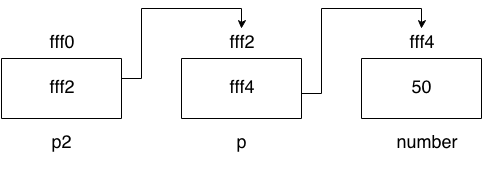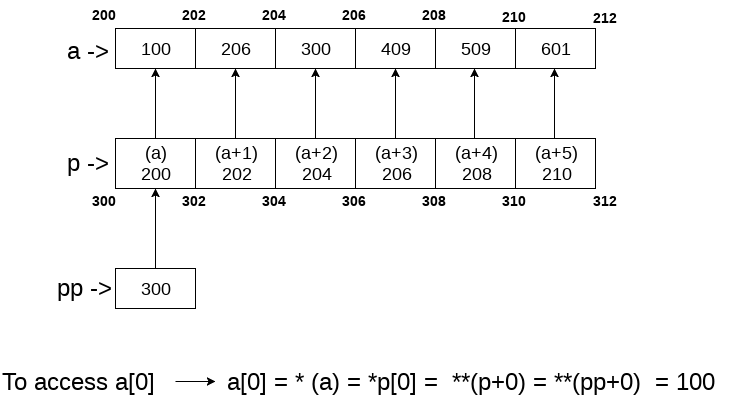TheDeveloperBlog.com
C-Sharp | Java | Python | Swift | GO | WPF | Ruby | Scala | F# | JavaScript | SQL | PHP | Angular | HTML
C Pointer to Pointer
C Pointer to Pointer with programming examples for beginners and professionals covering concepts, control statements, c array, c pointers, c structures, c union, c strings and more.
C Double Pointer (Pointer to Pointer)As we know that, a pointer is used to store the address of a variable in C. Pointer reduces the access time of a variable. However, In C, we can also define a pointer to store the address of another pointer. Such pointer is known as a double pointer (pointer to pointer). The first pointer is used to store the address of a variable whereas the second pointer is used to store the address of the first pointer. Let's understand it by the diagram given below. 
The syntax of declaring a double pointer is given below. int **p; // pointer to a pointer which is pointing to an integer. Consider the following example.
#include<stdio.h>
void main ()
{
int a = 10;
int *p;
int **pp;
p = &a; // pointer p is pointing to the address of a
pp = &p; // pointer pp is a double pointer pointing to the address of pointer p
printf("address of a: %x\n",p); // Address of a will be printed
printf("address of p: %x\n",pp); // Address of p will be printed
printf("value stored at p: %d\n",*p); // value stoted at the address contained by p i.e. 10 will be printed
printf("value stored at pp: %d\n",**pp); // value stored at the address contained by the pointer stoyred at pp
}
Outputaddress of a: d26a8734 address of p: d26a8738 value stored at p: 10 value stored at pp: 10 C double pointer example
Let's see an example where one pointer points to the address of another pointer. 
As you can see in the above figure, p2 contains the address of p (fff2), and p contains the address of number variable (fff4). #include OutputAddress of number variable is fff4 Address of p variable is fff4 Value of *p variable is 50 Address of p2 variable is fff2 Value of **p variable is 50 Q. What will be the output of the following program?
#include<stdio.h>
void main ()
{
int a[10] = {100, 206, 300, 409, 509, 601}; //Line 1
int *p[] = {a, a+1, a+2, a+3, a+4, a+5}; //Line 2
int **pp = p; //Line 3
pp++; // Line 4
printf("%d %d %d\n",pp-p,*pp - a,**pp); // Line 5
*pp++; // Line 6
printf("%d %d %d\n",pp-p,*pp - a,**pp); // Line 7
++*pp; // Line 8
printf("%d %d %d\n",pp-p,*pp - a,**pp); // Line 9
++**pp; // Line 10
printf("%d %d %d\n",pp-p,*pp - a,**pp); // Line 11
}
Explanation
In the above question, the pointer arithmetic is used with the double pointer. An array of 6 elements is defined which is pointed by an array of pointer p. The pointer array p is pointed by a double pointer pp. However, the above image gives you a brief idea about how the memory is being allocated to the array a and the pointer array p. The elements of p are the pointers that are pointing to every element of the array a. Since we know that the array name contains the base address of the array hence, it will work as a pointer and can the value can be traversed by using *(a), *(a+1), etc. As shown in the image, a[0] can be accessed in the following ways.
Coming to the program, Line 1 and 2 declare the integer and pointer array relatively. Line 3 initializes the double pointer to the pointer array p. As shown in the image, if the address of the array starts from 200 and the size of the integer is 2, then the pointer array will contain the values as 200, 202, 204, 206, 208, 210. Let us consider that the base address of the pointer array is 300; the double pointer pp contains the address of pointer array, i.e., 300. Line number 4 increases the value of pp by 1, i.e., pp will now point to address 302. Line number 5 contains an expression which prints three values, i.e., pp - p, *pp - a, **pp. Let's calculate them each one of them.
Therefore as the result of line 5, The output 1, 1, 206 will be printed on the console. On line 6, *pp++ is written. Here, we must notice that two unary operators * and ++ will have the same precedence. Therefore, by the rule of associativity, it will be evaluated from right to left. Therefore the expression *pp++ can be rewritten as (*(pp++)). Since, pp = 302 which will now become, 304. *pp will give 204. On line 7, again the expression is written which prints three values, i.e., pp-p, *pp-a, *pp. Let's calculate each one of them.
Therefore, as the result of line 7, The output 2, 2, 300 will be printed on the console. On line 8, ++*pp is written. According to the rule of associativity, this can be rewritten as, (++(*(pp))). Since, pp = 304, *pp = 204, the value of *pp = *(p[2]) = 206 which will now point to a[3]. On line 9, again the expression is written which prints three values, i.e., pp-p, *pp-a, *pp. Let's calculate each one of them.
Therefore, as the result of line 9, the output 2, 3, 409 will be printed on the console. On line 10, ++**pp is writen. according to the rule of associativity, this can be rewritten as, (++(*(*(pp)))). pp = 304, *pp = 206, **pp = 409, ++**pp => *pp = *pp + 1 = 410. In other words, a[3] = 410. On line 11, again the expression is written which prints three values, i.e., pp-p, *pp-a, *pp. Let's calculate each one of them.
Therefore as the result of line 9, the output 2, 3, 410 will be printed on the console. At last, the output of the complete program will be given as: Output 1 1 206 2 2 300 2 3 409 2 3 410
Next TopicPointer Arithmetic in C
|
Related Links:
- C# this
- C# static
- C# static class
- C# static constructor
- C# Main Thread
- C# Thread Sleep
- C# Structs
- C# Enum
- C# Properties
- C# Aggregation
- C# Member Overloading
- C# Method Overriding
- C# Base
- Learn C Programming Language Tutorial
- C# Polymorphism
- C# Sealed
- C# Abstract
- C# Interface
- C# Access Modifiers
- C# Namespaces
- C# Encapsulation
- C# Strings
- C# Exception Handling
- C# try-catch
- C# finally
- C# User Defined Exceptions
- C# Checked and Unchecked
- C# SystemException
- C# FileStream
- C# StreamWriter
- C# StreamReader
- C# TextWriter
- C# TextReader
- C# BinaryWriter
- C# FileInfo
- C# DirectoryInfo
- C# BinaryReader
- C# StringWriter
- C# StringReader
- C# Serialization
- C# Deserialization
- C# System.IO Namespace
- C# Collections
- C# List
- C# HashSet
- C# SortedSet
- C# Stack
- C# Queue
- C# LinkedList
- C# Dictionary
- C# Inheritance
- C# SortedDictionary
- C# SortedList
- C# Generics
- C# Delegates
- C# Reflection
- C# Anonymous Function
- C# Multithreading
- C# Thread Life Cycle
- C# Thread Class
- C# Threading Example
- C# Thread Abort
- C# ThreadPriority
- C# Thread Synchronization | C# Lock
- C Identifiers
- C Switch Statement
- C break statement
- C Array
- C Operators
- C Format Specifier
- C Pointers
- C Pointer to Pointer
- C if else statement
- C Programming Interview Questions (2021)
- C Loop
- C# Jagged Arrays
- C continue statement
- C goto statement
- C String Functions
- C strlen() function
- C strcpy() function
- C strcat() function
- C Union
- C vs C++
- Top 26 C# Interview Questions (2021)
- C strcmp() function
- C strrev() function
- C strlwr() function
- C strupr() function
- C strstr() function
- C Math Functions
- C# Thread Join
- C# Thread Name
- C Preprocessor
- C Macros
- C #include
- C #define
- C #undef
- C #ifdef
- C #ifndef
- C #if
- C #else
- C #error
- Learn C# Tutorial
- C #pragma
- C Expressions
- C Data Segments
- C Programs
- C# if else
- C# Do While Loop
- C Program to reverse number
- C Program to swap two numbers without using third variable
- C Program to print hello without semicolon
- C Program without main()
- C Program to print Alphabet Triangle
- C# Example
- C Program to convert Decimal to Binary
- C Program to convert Number in Characters
- C Strings
- C gets() and puts()
- C Program to print Number Triangle
- C Program to generate Fibonacci Triangle
- C# switch
- C# For Loop
- C# While Loop
- C# Break Statement
- C# Continue Statement
- C# Array to Function
- C# Multidimensional Array
- C# Goto Statement
- C# Comments
- C# Function
- C# Call By Value
- C# Call By Reference
- C# Out Parameter
- C# Arrays
- C# Params
- C# Array Class
- C# Command Line Arguments
- C# Object and Class
- C# Constructor
- C# Destructor

